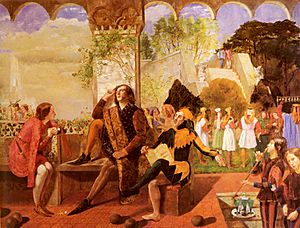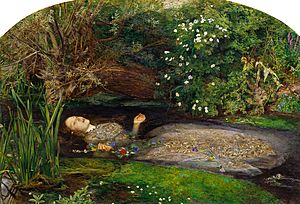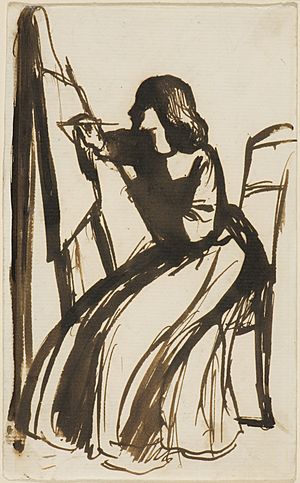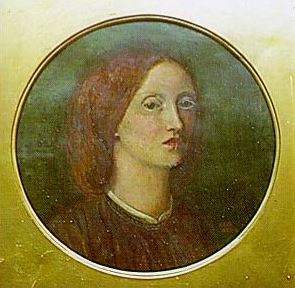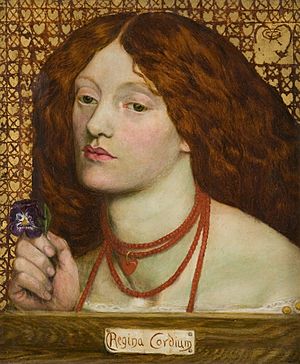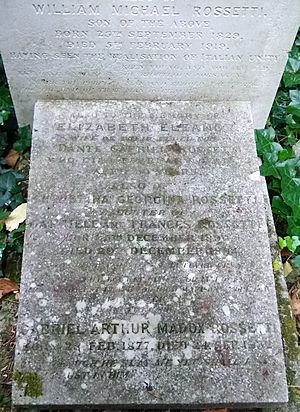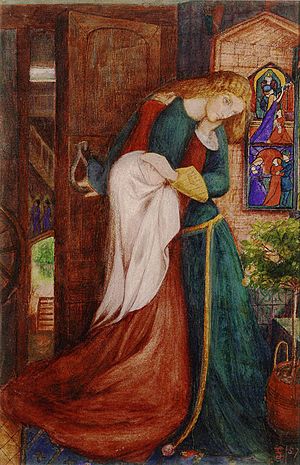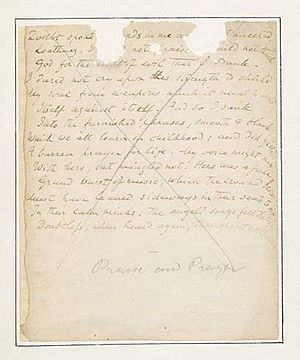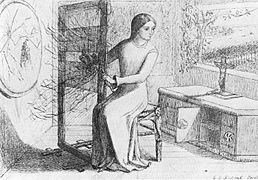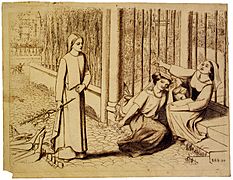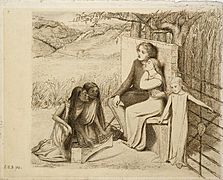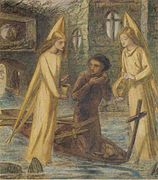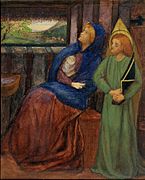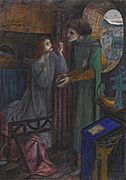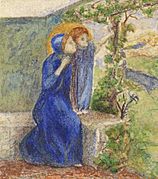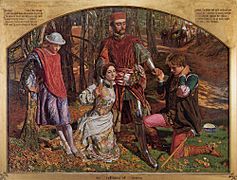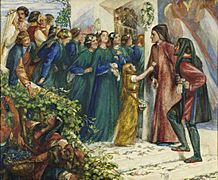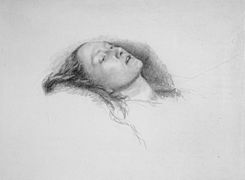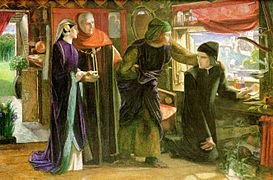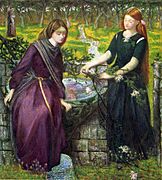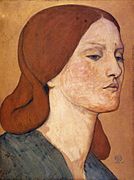Elizabeth Siddal facts for kids
Quick facts for kids
Elizabeth Siddal
|
|
|---|---|
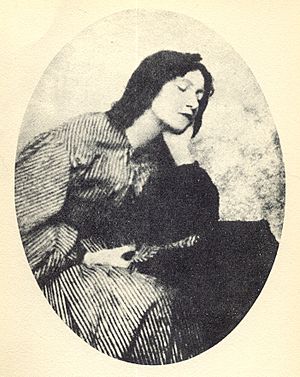
Elizabeth Siddal around 1860
|
|
| Born |
Elizabeth Eleanor Siddall
25 July 1829 London, England
|
| Died | 11 February 1862 (aged 32) Blackfriars, London, England
|
| Occupation |
|
| Spouse(s) | |
Elizabeth Eleanor Siddall (born July 25, 1829 – died February 11, 1862), known as Elizabeth Siddal, was a talented English artist, poet, and artist's model. You can find many of her artworks at Wightwick Manor and the Ashmolean Museum.
Many artists from the Pre-Raphaelite Brotherhood painted and drew Siddal. These included Walter Deverell, William Holman Hunt, and John Everett Millais. One famous painting of her is Millais's Ophelia from 1852. Her husband, Dante Gabriel Rossetti, also painted her often.
Contents
Early Life of Elizabeth Siddal
Elizabeth Eleanor Siddall was born on July 25, 1829. Her family lived at 7 Charles Street in Hatton Garden, London. Her parents were Charles Crooke Siddall and Elizabeth Eleanor Evans. She had two older siblings, Ann and Charles Robert. Her father owned a business that made cutlery.
Around 1831, her family moved to Southwark, a different part of London. Her younger siblings, Lydia, Mary, Clara, James, and Henry, were born there. Elizabeth was especially close to Lydia. She had a simple education. She discovered a love for poetry when she found some poems by Tennyson wrapped around butter. This inspired her to write her own poems from a young age.
Becoming a Pre-Raphaelite Model
In 1849, Elizabeth Siddal worked in a hat shop in London. There, she met Walter Deverell. Some say a friend noticed her and suggested her as a model to Deverell. Others say Deverell saw her when he visited the shop with his mother.
Deverell described Siddal as "magnificently tall" with a "lovely figure." He said she had "grey eyes" and "dazzling copper" hair. Deverell hired Siddal to model for his paintings. He then introduced her to the Pre-Raphaelite artists.
The Pre-Raphaelites liked to paint things as they really looked, not just ideal figures. For his painting Twelfth Night, Deverell used Siddal as the model for Viola/Cesario. This was her first time posing. She also modeled for William Holman Hunt in paintings like A Converted British Family Sheltering a Christian Missionary from the Persecution of the Druids (1849–1850).
For Millais's famous painting Ophelia, Siddal had to float in a bathtub full of water. Millais painted her daily during the winter. He used oil lamps to keep the water warm. One day, the lamps went out, and the water became very cold. Millais was so focused on his painting that he did not notice. Siddal did not complain, but she became very ill afterward. She caught a severe cold or pneumonia. Her father blamed Millais, who then paid for her doctor's bills.
Elizabeth's Relationship with Rossetti
Dante Gabriel Rossetti met Elizabeth Siddal in 1849. They likely met while both were modeling for Deverell. Rossetti gave her the nickname "Lizzie." By 1851, she became his main inspiration, or "muse." He started painting her almost exclusively. He also asked her to stop modeling for other artists.
In 1852, Siddal began to study art with Rossetti. That same year, they became very close and moved into his home. They became very focused on each other. They had sweet nicknames for each other, like "Guggums" and "Dove." Rossetti also shortened her last name to "Siddal," removing one 'l'.
Rossetti created many drawings of Siddal at home. These drawings often showed her looking relaxed and beautiful. She also inspired many of his poems. In one poem, A Last Confession, he describes his love for Siddal.
From 1853, Rossetti used Siddal as a model for paintings based on the poet Dante. These included The First Anniversary of the Death of Beatrice (1852) and Dante's Vision of Rachel and Leah (1855). Perhaps his most famous portrait of her is Beata Beatrix (1864–1870). He painted this as a tribute after she passed away. It is believed that Rossetti created thousands of drawings, paintings, and poems featuring Siddal.
Elizabeth's Own Art and Poetry
In 1854, Elizabeth Siddal painted a self-portrait. It showed her in a way that was different from the usual idealized Pre-Raphaelite style. In 1855, a famous art critic named John Ruskin started to support her art career. He paid her £150 each year for all the drawings and paintings she made.
She created many sketches, drawings, and watercolors. She also made one oil painting. Her sketches often showed scenes from Arthurian legends and medieval stories. She showed her work with the Pre-Raphaelites in an exhibition in 1857.
Between 1852 and 1861, Siddal created over 100 artworks. She also wrote poetry during this time. Her poems often had sad themes about lost love or how hard it was to find true love. Critic William Gaunt said her poems were "simple and moving." Both Rossetti and Ford Madox Brown admired her work.
Marriage to Rossetti
Elizabeth Siddal came from a working-class family. Rossetti was worried about introducing her to his parents. His sisters were also quite critical of her. Rossetti delayed their marriage partly because he knew his family might not approve. Siddal sometimes felt he might be looking for new inspiration, which made her feel sad and unwell.
Just before they married, Rossetti painted a famous portrait of Siddal called Regina Cordium (The Queen of Hearts) in 1860. This painting shows a close-up, colorful image of Siddal.
Elizabeth Siddal and Dante Gabriel Rossetti married on May 23, 1860. The wedding took place at St. Clement's Church in Hastings, a seaside town. No family or friends were there, only a few witnesses they asked in Hastings.
Health Challenges and Passing Away
It was once thought that Elizabeth Siddal had tuberculosis. However, some historians now think she might have had an intestinal problem. She suffered a lot from neuralgia, which is severe nerve pain. She took medicine to help with the pain. Some also think she might have been anorexic, while others believe her poor health was due to several illnesses combined.
Siddal traveled to Paris and Nice for several years to improve her health. When she got married, she was so weak that she had to be carried to the church, even though it was a very short walk. In 1861, Siddal became pregnant. Sadly, she had a baby who did not survive.
Elizabeth Siddal passed away on February 11, 1862, at their home in Chatham Place. The official ruling for her death was accidental.
After Elizabeth Siddal's Death
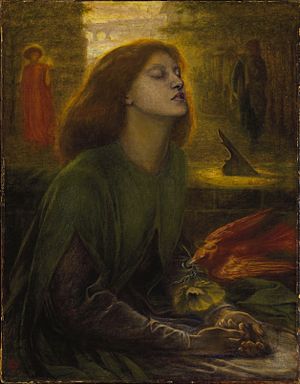
Elizabeth Siddal was buried in the Rossetti family grave at Highgate Cemetery in London. Her father-in-law, Gabriele Rossetti, was already buried there. Later, other family members, including Christina Rossetti and William Michael Rossetti, were also buried in the same grave.
In 1869, Rossetti decided to get a book of his handwritten poems back. He had placed this book beside Siddal's head when she was buried. With help, the book was retrieved and cleaned. Rossetti then published these poems in 1870.
Elizabeth Siddal's Legacy
The house where Elizabeth Siddal and Rossetti lived at 14 Chatham Place was later torn down. The area is now covered by Blackfriars Station.
Exhibitions and Collections of Her Work
The first time Elizabeth Siddal's art was shown alone in an exhibition was in 1991. It was put together by Jan Marsh at the Ruskin Gallery in Sheffield.
In the 1960s, Rosalie Glynn Grylls and Geoffrey Mander bought many of her artworks for a high price. They then gave these artworks to the National Trust. In 2018, an exhibition called "Beyond Ophelia" was held at Wightwick Manor. It showed twelve of Siddal's artworks owned by the National Trust. This exhibition looked at Siddal's career and the challenges she faced as a female artist.
Her oil painting Self Portrait (1853–54) and the watercolor Lady Clare (1857) are now in private collections.
Other works like Lady Affixing a Pennant to a Knight’s Spear (1856) and The Quest of the Holy Grail(1855) have been shown at the Tate Gallery in London.
Her finished drawings The Lady of Shalott and Pippa Passes (1854) are displayed in the J.S. Maas Collection and the Ashmolean Museum in Oxford.
Siddal's paintings also include Clerk Saunders (1857), The Haunted Wood, and Madonna and Child with an Angel (around 1856).
Gallery
Works by Elizabeth Siddal
Works with Elizabeth Siddal as a Model
-
William Holman Hunt, Two Gentlemen of Verona, Valentine Rescuing Sylvia From Proteus, 1850 or 1851.
See also
 In Spanish: Elizabeth Siddal para niños
In Spanish: Elizabeth Siddal para niños


